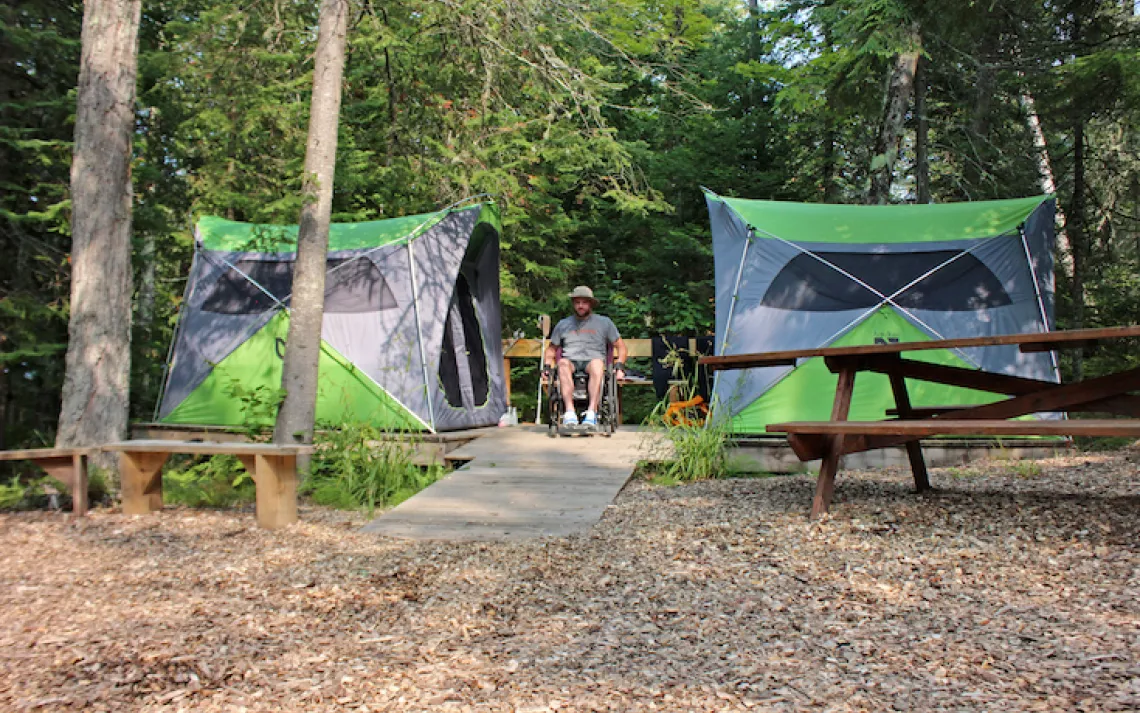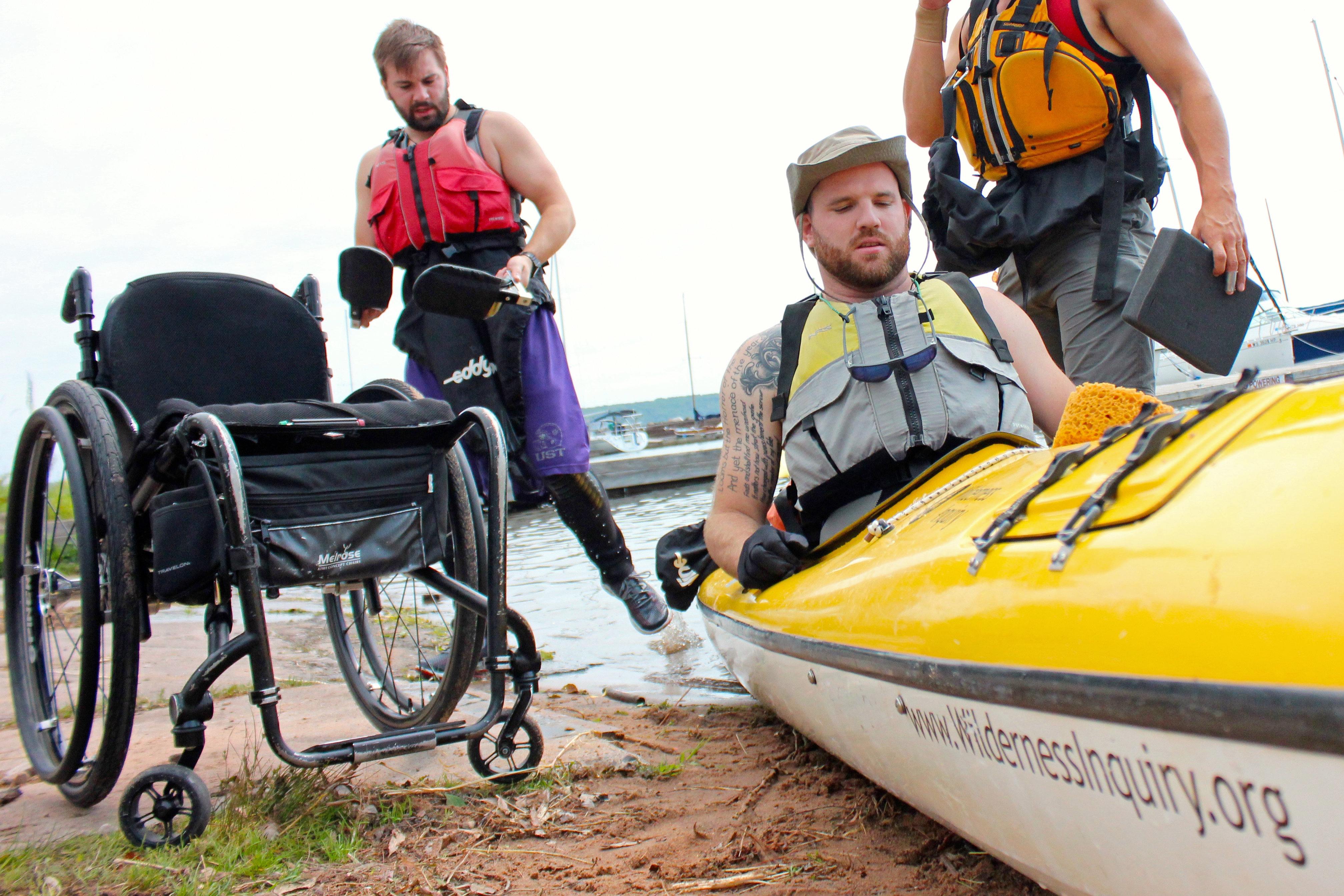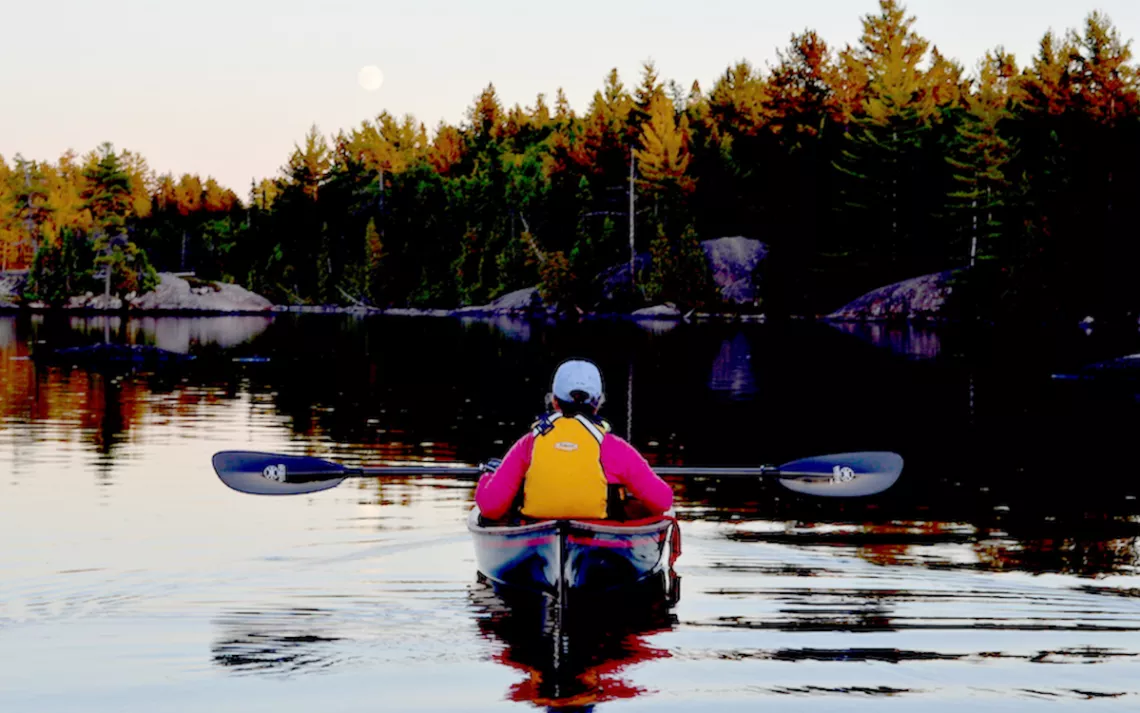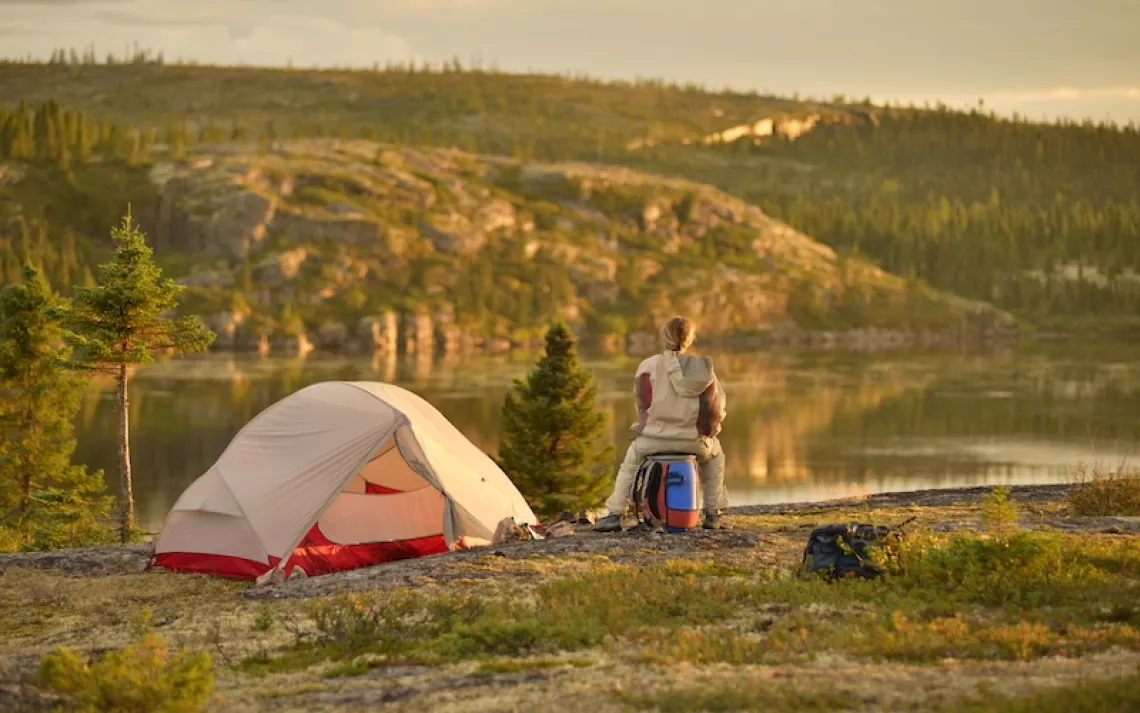In Defense of Glamping

Wilderness Inquiry offers wheelchair-accessible campsites at its Apostle Island base camp in Wisconsin. | Photo by Mullen, A.
Among the outdoorsy set, few topics are as likely to spark heated debate as the trend known as “glamping” (an ugly mash-up of “glamour” and “camping”). The term conjures up accommodations that are at once posh and woodsy. Think: Swiss Family Robinson-style treehouses, safari tents with high-thread-count linens, tepees with wi-fi. For some, glamping is simply camping made more comfortable. Others have a darker view. One critic has called it “nature on a silver platter.” In the New York Times last year, a contributing editor for Outside, Christopher Solomon, warned that glamping in state parks threatens to make camping something that only the affluent can afford.
This might all be true. But, at the same time, it’s crucial to remember that for some people—those with disabilities, the elderly, and some families with small children—glamping might be the only way they can enjoy the outdoors. Glamping can make the outdoors accessible.
Exhibit A: Wilderness Inquiry, an outfitter that runs outdoor adventure trips to Yellowstone National Park, the Boundary Waters Wilderness, Glacier National Park, and other destinations for people with and without disabilities. Its trips include backcountry and base-camp trips, and, yes, the company acknowledges that some of them are glamping. However, “what some people consider glamping, others would consider roughing it,” says Wilderness Inquiry’s operations director, Nell Holden.
Nora Boyle is among those who have taken part in a Wilderness Inquiry trip. Boyle’s first camping experience was a glamping trip to Wisconsin’s Apostle Islands organized by the outfitter. She uses a wheelchair, and she said that she wouldn’t have considered traditional camping. On the trip, she kayaked and canoed for the first time since she had been in a wheelchair. “I never thought I would go canoeing or kayaking,” Boyle says. “I knew I could. I just didn’t think it’d be this easy.”
Boyle’s tent was on a platform and had a wheelchair ramp. Guides helped her in and out of kayaks and canoes, and they gave her wheelchair a push on trail hikes when she needed it.
As she and her family were about to do a kayak tip test, her 14-year-old daughter, who has autism, got anxious and started crying. “Once she gets so scared, it’s hard to get her to calm down,” Boyle says. But a guide talked her through it, and she overcame her fear. “She was proud of herself,” Boyle says.
Boyle says she appreciated the attention the Wilderness Inquiry staff gave her family. Meals and other necessities were taken care of. Buying and managing all the gear her family would have needed would have been expensive and stressful, she says, and she was glad for a glamping experience that provided everything and let her family try out the experience before buying a bunch of gear.

Kayakers set out from the Wilderness Inquiry base camp at the Apostle Islands National Lakeshore in Wisconsin. | Photo by Mullen, A.
For travelers with disabilities, Wilderness Inquiry can provide trip assistants, such as sign language interpreters. Holden says the company has worked with clients who have brought along family members with disabilities who they didn’t think could go camping. Through these outdoor adventures, “they realize that things are still possible,” she says.
Two men with traumatic brain injuries, who met on a trip but live in different areas of the country, plan a trip together every year, Holden says. They say that they keep coming back “because they know they’ll be treated like everyone else on the trips, when in their everyday lives, they are not always treated the same.”
The Oregon Parks and Recreation Department is one public agency that has embraced glamping as a way to broaden access to parks. The brochure for its yurts, cabins, and tepees is labeled “camping lite,” and the department rents out cabins and yurts in “rustic” or “deluxe” versions; the deluxe options include refrigerators and bathrooms.
“We want to provide an avenue for everyone to enjoy our camps,” says Richard Walkoski, ADA Coordinator for Oregon Parks, making the argument that glamping isn’t lesser than camping. “If that’s the only way you can go camping or that’s the way you prefer to go camping, it is real camping.”
Oregon Parks provides an access pass for disabled veterans, and a large disabled community uses the parks, Walkoski says. The aim is “to encourage people who came back after a life-altering event to get back and do some of the things they used to do before.”
The National Park Service is seeing a higher demand for accessible campsites, and meeting this demand is important, says Jeremy Buzzell, chief of the Park Service’s National Accessibility Branch. “We are America’s parks—we belong to the people,” he says. “For us to have any segment of the population not able to access them, that undermines our passion and purpose.”
To make a campground accessible, planners seek to make surfaces as stable and level as possible, removing obstructions like roots that wheelchairs would have difficulty navigating. Other considerations include picnic tables designed to allow a wheelchair user to sit with their companions, fire pits that are at the right height and have enough room around them, and water spigots and trash receptacles that are easy enough for people with dexterity or strength challenges to operate. “It also is important to ensure that those with visual or hearing disabilities can fully participate in the experience,” Buzzell says.
Bruce Moulton, 81, with two Wilderness Inquiry guides in Yellowstone National Park. | Photo by Koller, A.
For some aspiring campers, age can be a factor that makes the idea of glamping appealing. As Baby Boomers get older, many are “likely to finally want to take that trip to the national parks,” Buzzell says, and “folks will want to continue with their outdoor pursuits as they age.” Some elderly people opt for glamping to do just that. “Last summer, a couple in their 90s wanted to sign up for a trip,” Holden of Wilderness Inquiry says, “and they chose a family trip” because the pace was right for them—the kid-friendly hikes were also doable for the 90-plus glampers.
Bruce Moulton, 81, travels and volunteers with Wilderness Inquiry. He used to do a lot of backpacking, but now he prefers trips that don’t require him to carry his gear. He recently went to Yellowstone, where his group used a base camp and took side trips. “We packed everything in canoes and camped along the way,” he says.
But he wouldn’t call what he does glamping. “This is not luxury camping,” he says, comparing his trips to the ones he’s seen with luxury tents, which he calls “a little too much.” Still, he wants “to experience the wilderness without really, really roughing it.”
For families with young children, glamping offers an alternative to totally roughing it. Cheryl Leung, who blogs about traveling with kids, was uninterested in traditional camping, so she took her first glamping trip at a KOA cabin. At the time, her son was in the middle of potty training. “Traditional camping would mean us taking our son through the woods to the shared bathroom regularly throughout the night—this was not something we wanted to do,” she says.
Leung wouldn’t call the KOA luxurious, but it fit the bill. “I think glamping is a really good way to introduce young kids to the world of camping.”
For Leung, like many other glampers, the bottom line is comfort level, not necessarily the degree of luxury. Is glamping offensive if it gets people out into the wilderness who couldn’t—or wouldn’t—take the plunge otherwise?
To Jeremy Buzzell of the Park Service and Richard Walkoski of the Oregon Parks department, glamping gets people out there—so it doesn’t deserve all the venom. And who gets to say what’s good camping and what’s bad camping, anyway? Walkoski says he learned a long time ago that “my camping preferences are valid for me but might not mean a thing to someone else.”
Wilderness Inquiry's base camp at the Apostle Islands National Lakeshore in Wisconsin. | Photo by Mullen, A.
 The Magazine of The Sierra Club
The Magazine of The Sierra Club






